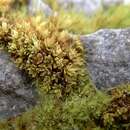Comments
(
Anglèis
)
fornì da eFloras
The yellow seta, mostly plane margins, and large tubers, when present, buried in the soil, and the operculum commonly as long as the theca readily distinguish Barbula convoluta from the similar B. unguiculata. Bryoerythrophyllum ferruginascens also has tubers, but the lamina is red in KOH solution. The small antheridiate plants that appear as buds on the soil indicate the possibility of rhizautoicy, as noted by A. Casares-Gil and A. Caballero (1919-1932, vol. 2), but, because they are usually grouped, they may have been generated on protonema of a separate spore. This is one of the few species of the family to fruit in the Arctic. When sterile, Barbula convoluta may be quickly distinguished from the hygrophile Gymnostomum aeruginosum by its leaves very deeply keeled distal to mid leaf, and leaf tips more commonly reflexed and more broadly acute or rounded. Barbula convoluta differs from B. indica by its simple papillae on the abaxial surface of the costa and the commonly papillose clear cell of the apiculus, when present. Syntrichia amplexa is occasionally mistaken for B. convoluta but is immediately identified by its recurved leaf margins and red color in KOH. Although var. eustegia is clearly a western taxon, attempting to ascribe North American sterile collections to either var. eustegia or the typical variety (or fertile collections to any European variety with consistency in character combination) is presently futile (R. H. Zander 1997).
- licensa
- cc-by-nc-sa-3.0
- drit d'autor
- Missouri Botanical Garden, 4344 Shaw Boulevard, St. Louis, MO, 63110 USA
Description
(
Anglèis
)
fornì da eFloras
Plants small, less than 10 mm high, yellowish green, in dense tufts. Stems erect, usually irregularly branched, often radiculose at base. Leaves contorted when dry, erect-spreading when moist, oblong-elliptic to narrowly ligulate, obtusely acute to rounded obtuse; margins entire, slightly recurved in lower 1/2–2/3 the leaf length, sometimes undulate; costa stout, percurrent or ending below the apex; upper leaf cells small, rounded-hexagonal, rather thick-walled, obscure, multi-papillose; basal cells differentiated, irregularly rectangular, smooth, hyaline. Dioicous. Perichaetial leaves sheathing at base, inner perichaetial leaves highly convolute, obtuse at apex. Setae ca. 20 mm long, reddish yellow; capsules erect to suberect, oblong-ovoid; peristome teeth, filiform, twisted.
- licensa
- cc-by-nc-sa-3.0
- drit d'autor
- Missouri Botanical Garden, 4344 Shaw Boulevard, St. Louis, MO, 63110 USA
Description
(
Anglèis
)
fornì da eFloras
Stems to 1-1.5 cm. Leaves firm when wet, long-ligulate to broadly lanceolate from an oblong base, seldom ovate, 1-1.7 mm, base often elliptic, widened not strongly sheathing, margins plane or weakly recurved in proximal 1/3, apex broadly acute to rounded, entire or apiculate; costa ending 1-6 cells before the apex, rarely excurrent, abaxial costal surface with scattered solid papillae, hydroids absent; distal laminal cells firm-walled, quadrate, 8-10 µm wide, 1:1, papillose. Specialized asexual reproduction by large, spheric to elliptic, red-brown tubers born on an often dense mass of rhizoids buried in soil, 100 to 250 µm long, or in var. gallinula by large gemmae, 120-250 µm, occurring usually singly in leaf axils. Perichaetial leaves obtuse to broadly acute strongly sheathing and convolute; antheridiate plants short-stemmed (to 2 mm), appearing as buds on soil at base of archegoniate plants. Seta 1-1.8 cm. Theca 0.8-1.2 mm. Spores 10-12 µm.
- licensa
- cc-by-nc-sa-3.0
- drit d'autor
- Missouri Botanical Garden, 4344 Shaw Boulevard, St. Louis, MO, 63110 USA
Distribution
(
Anglèis
)
fornì da eFloras
Distribution: China and Japan.
- licensa
- cc-by-nc-sa-3.0
- drit d'autor
- Missouri Botanical Garden, 4344 Shaw Boulevard, St. Louis, MO, 63110 USA
Habitat
(
Anglèis
)
fornì da eFloras
Habitat: on rocks or thin soil on rocks.
- licensa
- cc-by-nc-sa-3.0
- drit d'autor
- Missouri Botanical Garden, 4344 Shaw Boulevard, St. Louis, MO, 63110 USA
Synonym
(
Anglèis
)
fornì da eFloras
Tortula convoluta (Hedw.) Gaertn., Meyer & Scherb., Oekon. Fl. Wetterau 3(2): 92. 1802. Streblotrichum convolutum (Hedw.) P. de Beauv., Prodr. Aethéogam. 89. 1805.
Barbula subconvoluta C. Müll., Nuovo Giorn. Bot. Ital., n. ser. 5: 183. 1898. Type. China: Shaanxi (Schen-si), Tui-kio-san, P. J. Giraldi 1812 (isotype H).
- licensa
- cc-by-nc-sa-3.0
- drit d'autor
- Missouri Botanical Garden, 4344 Shaw Boulevard, St. Louis, MO, 63110 USA

